7113EDN Assignment 1: Critical Analysis of Reading Theories
VerifiedAdded on 2022/08/26
|10
|2813
|26
Essay
AI Summary
This essay undertakes a critical analysis of two prominent reading theories: schema theory and behaviourism. It begins by defining and exploring the core principles of each theory, including how schema theory emphasizes the role of prior knowledge in comprehension and how behaviourism focuses on observable behaviors and reinforcement. The analysis then applies these theories to the context of the Australian English curriculum for P-3, examining how they inform the teaching of reading skills. The essay further provides a critical evaluation of the approaches and strategies used to teach reading in the early years, considering the strengths and weaknesses of each theory in practice. Finally, it offers a critical reflection on the appropriateness of these theories for fostering early reading development, considering their limitations and potential for enhancing comprehension and literacy skills.
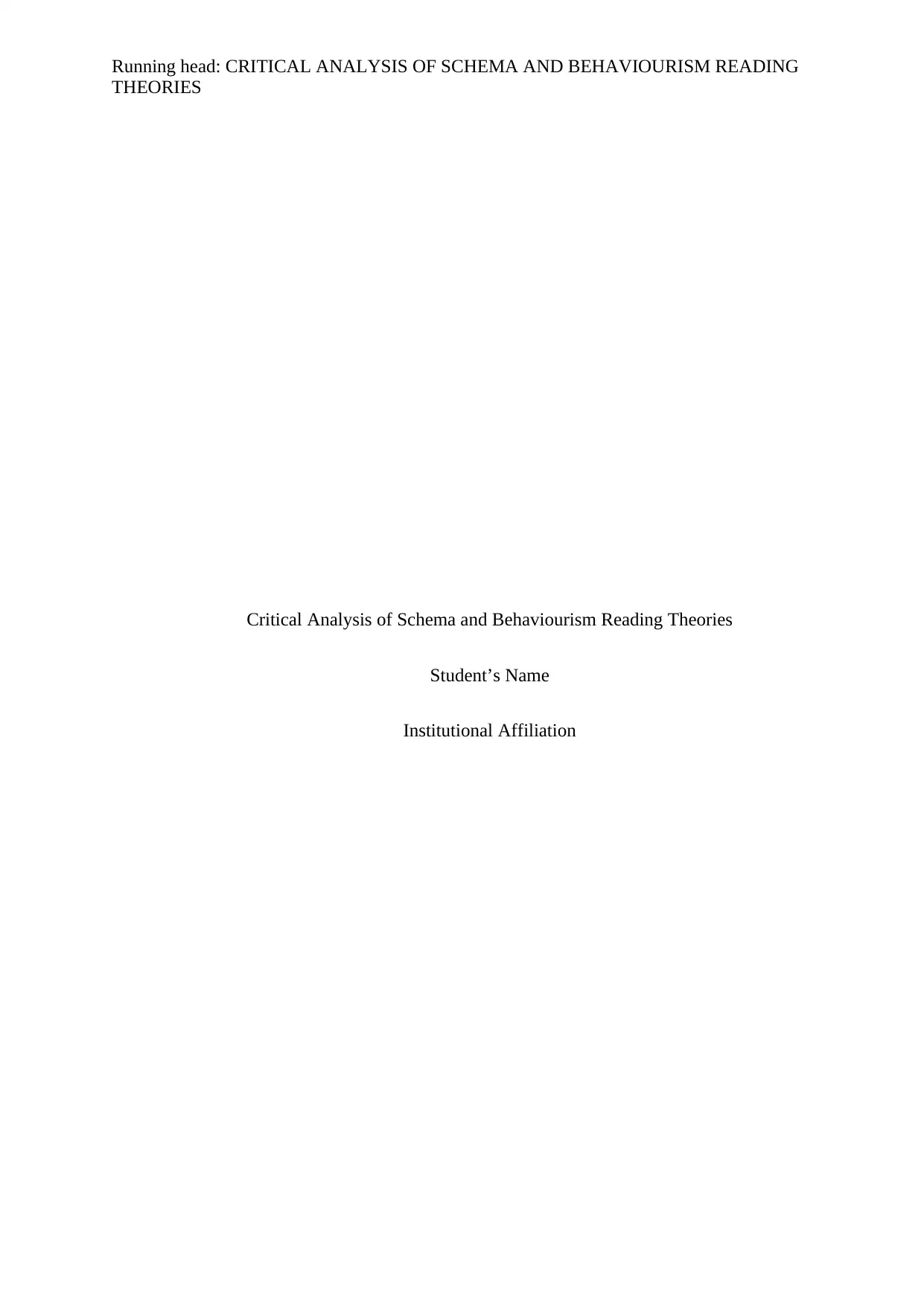
Running head: CRITICAL ANALYSIS OF SCHEMA AND BEHAVIOURISM READING
THEORIES
Critical Analysis of Schema and Behaviourism Reading Theories
Student’s Name
Institutional Affiliation
THEORIES
Critical Analysis of Schema and Behaviourism Reading Theories
Student’s Name
Institutional Affiliation
Paraphrase This Document
Need a fresh take? Get an instant paraphrase of this document with our AI Paraphraser

CRITICAL ANALYSIS OF SCHEMA AND BHEAVIOURISM READING
THEORIES 2
Introduction
There are numerous reading theories that exist in the contemporary learning
environment. This essay will provide a critical analysis of two of these theories, that is the
schema theory and the behaviourism theory. After the critical analysis, the essay will look at
how these theories apply to the Australian English curriculum for P-3. The essay will further
focus on a critical evaluation of the teaching strategies and approaches that are used to teach
English in P-3. Lastly, a critical reflection focusing on how appropriate the theories are in
enhancing reading development among early learners will be provided.
Schema Theory
According to Curtis & Jaboneta (2019), schema theory assumes that learners use
knowledge that they have gained previously to comprehend and understand some text. The
fundamental principle behind the theory is that the learner does not gain any new knowledge
through reading a text. Rather, the learner uses previously gained knowledge to derive some
meaning out of a text. Therefore, there is some kind of an interactive background between
what the learner already knows and the text. As Neumann & Kopcha (2018) observes for
some efficient comprehension of the text, the learner must always be able to connect some
line between what they know and what is present in the text. It follows that the kind of
environment in which children from P-3 revolve around, will have a phenomenal impact in
their development of reading capability. The schema theory further points out that the
understanding of the world that a learner has will significantly influence the act of text
comprehension (Odom, 2016).
The schema theory further argues that there are two main directions in which learning
takes place (Curtis & Jaboneta, 2019). The first direction is bottom up to the top while the
THEORIES 2
Introduction
There are numerous reading theories that exist in the contemporary learning
environment. This essay will provide a critical analysis of two of these theories, that is the
schema theory and the behaviourism theory. After the critical analysis, the essay will look at
how these theories apply to the Australian English curriculum for P-3. The essay will further
focus on a critical evaluation of the teaching strategies and approaches that are used to teach
English in P-3. Lastly, a critical reflection focusing on how appropriate the theories are in
enhancing reading development among early learners will be provided.
Schema Theory
According to Curtis & Jaboneta (2019), schema theory assumes that learners use
knowledge that they have gained previously to comprehend and understand some text. The
fundamental principle behind the theory is that the learner does not gain any new knowledge
through reading a text. Rather, the learner uses previously gained knowledge to derive some
meaning out of a text. Therefore, there is some kind of an interactive background between
what the learner already knows and the text. As Neumann & Kopcha (2018) observes for
some efficient comprehension of the text, the learner must always be able to connect some
line between what they know and what is present in the text. It follows that the kind of
environment in which children from P-3 revolve around, will have a phenomenal impact in
their development of reading capability. The schema theory further points out that the
understanding of the world that a learner has will significantly influence the act of text
comprehension (Odom, 2016).
The schema theory further argues that there are two main directions in which learning
takes place (Curtis & Jaboneta, 2019). The first direction is bottom up to the top while the
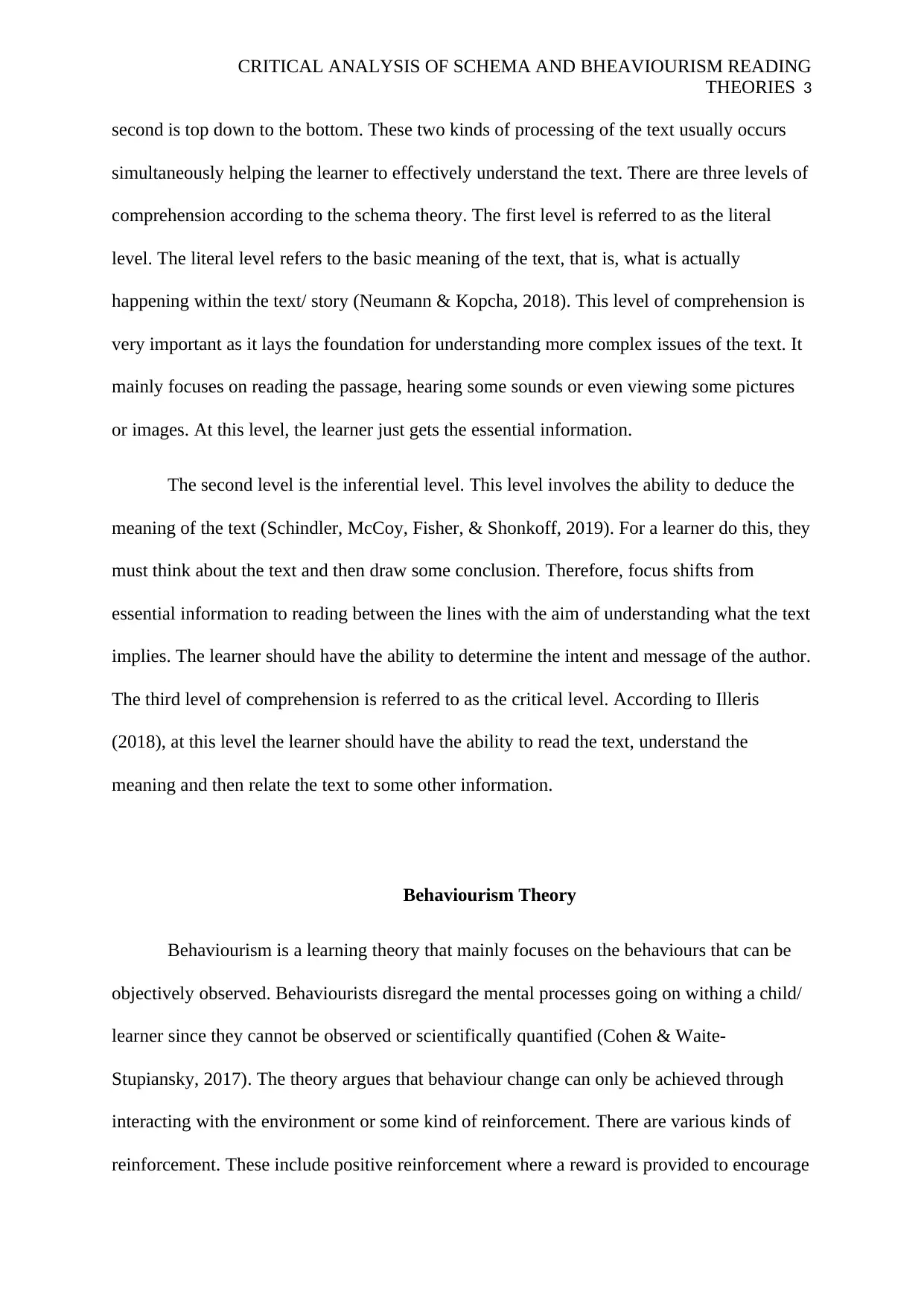
CRITICAL ANALYSIS OF SCHEMA AND BHEAVIOURISM READING
THEORIES 3
second is top down to the bottom. These two kinds of processing of the text usually occurs
simultaneously helping the learner to effectively understand the text. There are three levels of
comprehension according to the schema theory. The first level is referred to as the literal
level. The literal level refers to the basic meaning of the text, that is, what is actually
happening within the text/ story (Neumann & Kopcha, 2018). This level of comprehension is
very important as it lays the foundation for understanding more complex issues of the text. It
mainly focuses on reading the passage, hearing some sounds or even viewing some pictures
or images. At this level, the learner just gets the essential information.
The second level is the inferential level. This level involves the ability to deduce the
meaning of the text (Schindler, McCoy, Fisher, & Shonkoff, 2019). For a learner do this, they
must think about the text and then draw some conclusion. Therefore, focus shifts from
essential information to reading between the lines with the aim of understanding what the text
implies. The learner should have the ability to determine the intent and message of the author.
The third level of comprehension is referred to as the critical level. According to Illeris
(2018), at this level the learner should have the ability to read the text, understand the
meaning and then relate the text to some other information.
Behaviourism Theory
Behaviourism is a learning theory that mainly focuses on the behaviours that can be
objectively observed. Behaviourists disregard the mental processes going on withing a child/
learner since they cannot be observed or scientifically quantified (Cohen & Waite-
Stupiansky, 2017). The theory argues that behaviour change can only be achieved through
interacting with the environment or some kind of reinforcement. There are various kinds of
reinforcement. These include positive reinforcement where a reward is provided to encourage
THEORIES 3
second is top down to the bottom. These two kinds of processing of the text usually occurs
simultaneously helping the learner to effectively understand the text. There are three levels of
comprehension according to the schema theory. The first level is referred to as the literal
level. The literal level refers to the basic meaning of the text, that is, what is actually
happening within the text/ story (Neumann & Kopcha, 2018). This level of comprehension is
very important as it lays the foundation for understanding more complex issues of the text. It
mainly focuses on reading the passage, hearing some sounds or even viewing some pictures
or images. At this level, the learner just gets the essential information.
The second level is the inferential level. This level involves the ability to deduce the
meaning of the text (Schindler, McCoy, Fisher, & Shonkoff, 2019). For a learner do this, they
must think about the text and then draw some conclusion. Therefore, focus shifts from
essential information to reading between the lines with the aim of understanding what the text
implies. The learner should have the ability to determine the intent and message of the author.
The third level of comprehension is referred to as the critical level. According to Illeris
(2018), at this level the learner should have the ability to read the text, understand the
meaning and then relate the text to some other information.
Behaviourism Theory
Behaviourism is a learning theory that mainly focuses on the behaviours that can be
objectively observed. Behaviourists disregard the mental processes going on withing a child/
learner since they cannot be observed or scientifically quantified (Cohen & Waite-
Stupiansky, 2017). The theory argues that behaviour change can only be achieved through
interacting with the environment or some kind of reinforcement. There are various kinds of
reinforcement. These include positive reinforcement where a reward is provided to encourage
⊘ This is a preview!⊘
Do you want full access?
Subscribe today to unlock all pages.

Trusted by 1+ million students worldwide
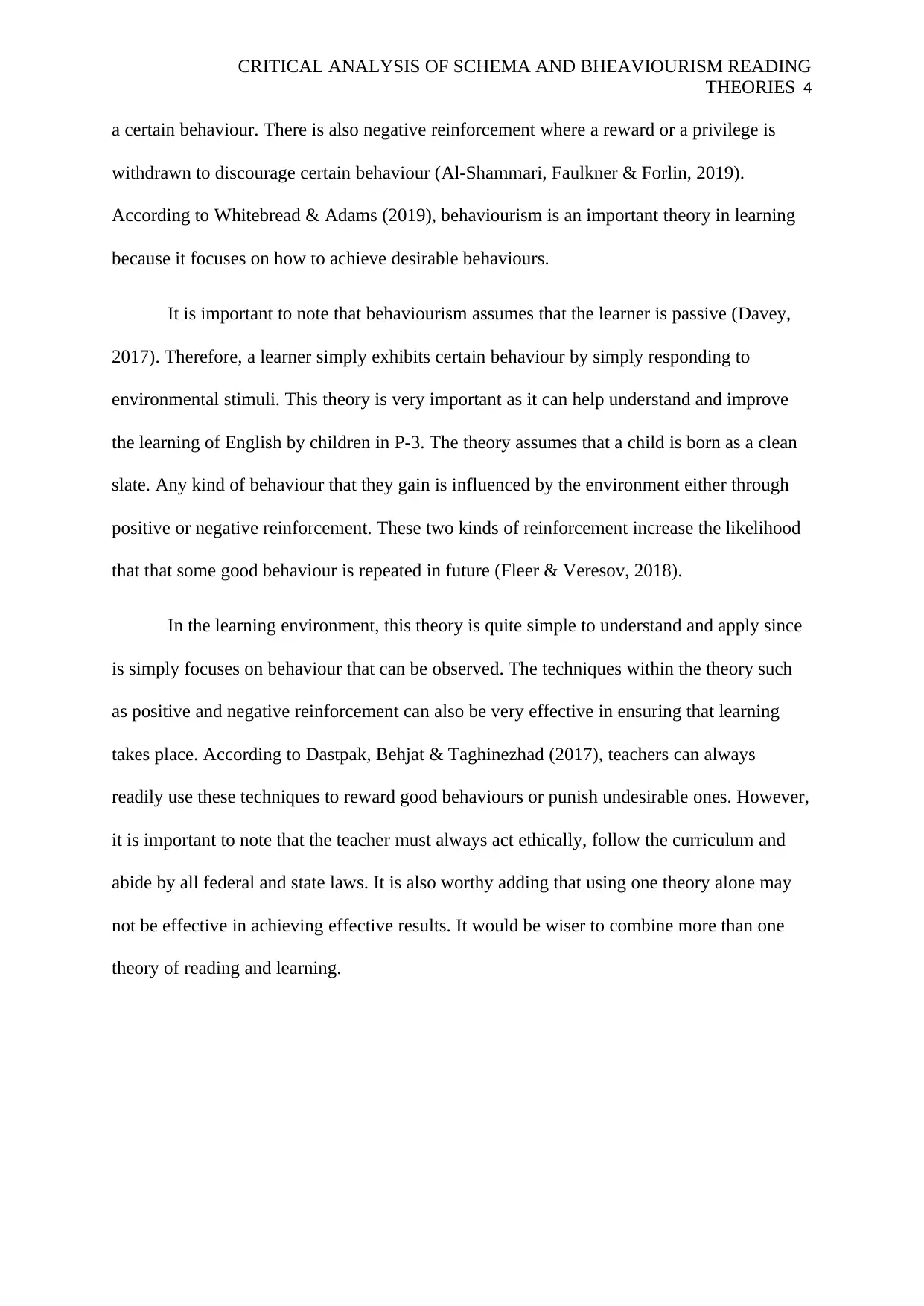
CRITICAL ANALYSIS OF SCHEMA AND BHEAVIOURISM READING
THEORIES 4
a certain behaviour. There is also negative reinforcement where a reward or a privilege is
withdrawn to discourage certain behaviour (Al-Shammari, Faulkner & Forlin, 2019).
According to Whitebread & Adams (2019), behaviourism is an important theory in learning
because it focuses on how to achieve desirable behaviours.
It is important to note that behaviourism assumes that the learner is passive (Davey,
2017). Therefore, a learner simply exhibits certain behaviour by simply responding to
environmental stimuli. This theory is very important as it can help understand and improve
the learning of English by children in P-3. The theory assumes that a child is born as a clean
slate. Any kind of behaviour that they gain is influenced by the environment either through
positive or negative reinforcement. These two kinds of reinforcement increase the likelihood
that that some good behaviour is repeated in future (Fleer & Veresov, 2018).
In the learning environment, this theory is quite simple to understand and apply since
is simply focuses on behaviour that can be observed. The techniques within the theory such
as positive and negative reinforcement can also be very effective in ensuring that learning
takes place. According to Dastpak, Behjat & Taghinezhad (2017), teachers can always
readily use these techniques to reward good behaviours or punish undesirable ones. However,
it is important to note that the teacher must always act ethically, follow the curriculum and
abide by all federal and state laws. It is also worthy adding that using one theory alone may
not be effective in achieving effective results. It would be wiser to combine more than one
theory of reading and learning.
THEORIES 4
a certain behaviour. There is also negative reinforcement where a reward or a privilege is
withdrawn to discourage certain behaviour (Al-Shammari, Faulkner & Forlin, 2019).
According to Whitebread & Adams (2019), behaviourism is an important theory in learning
because it focuses on how to achieve desirable behaviours.
It is important to note that behaviourism assumes that the learner is passive (Davey,
2017). Therefore, a learner simply exhibits certain behaviour by simply responding to
environmental stimuli. This theory is very important as it can help understand and improve
the learning of English by children in P-3. The theory assumes that a child is born as a clean
slate. Any kind of behaviour that they gain is influenced by the environment either through
positive or negative reinforcement. These two kinds of reinforcement increase the likelihood
that that some good behaviour is repeated in future (Fleer & Veresov, 2018).
In the learning environment, this theory is quite simple to understand and apply since
is simply focuses on behaviour that can be observed. The techniques within the theory such
as positive and negative reinforcement can also be very effective in ensuring that learning
takes place. According to Dastpak, Behjat & Taghinezhad (2017), teachers can always
readily use these techniques to reward good behaviours or punish undesirable ones. However,
it is important to note that the teacher must always act ethically, follow the curriculum and
abide by all federal and state laws. It is also worthy adding that using one theory alone may
not be effective in achieving effective results. It would be wiser to combine more than one
theory of reading and learning.
Paraphrase This Document
Need a fresh take? Get an instant paraphrase of this document with our AI Paraphraser

CRITICAL ANALYSIS OF SCHEMA AND BHEAVIOURISM READING
THEORIES 5
Application of Theories to the Content of the Australian English Curriculum(P-
3)
There exists some relation between the two theories discussed in the previous section
with the Australian English curriculum for P-3. This section will provide some discussion and
illustration to this effect. The schema theory provides for the three levels of comprehension
that a learner could have. The curriculum focuses on ensuring that early learner (P-3) have
the ability to understand that English is one of the various languages used in Australia. It also
focuses on ensuring that students learn interaction between various English words and why
such interaction is important to derive meaning. In addition, the learners should also be
equipped with the ability to differentiate between use of capital letters and lower-case letter.
For instance, they should understand that proper nouns should always begin with an
uppercase. The learners should also be taught on how to use such features of text as commas
and full stops. It would be true to conclude that these provisions of the curriculum as aimed at
ensuring that the student gains the ability to gain the essential meaning of a text. For instance,
if a child can understand the usage of a comma in a sentence, they are able to derive the basic
meaning of a text. Later in year 2 and beyond, the child should be able to infer from the text
and even relate the text to other information.
There exists a great relationship between behaviourism and the Australian English
Curriculum P-3. The main way through which teachers assess the learner capability of
reading and learning is mainly through observation of behaviours. For instance, the teacher
may require a child to read some simple text to gauge whether the child has developed the
ability to pronounce syllables well. As Bassok, Dee & Latham (2019) argue, such text mat
also helps the teacher know whether the child knows how to pause where there is a comma or
a longer pause for a full stop. Some other observable behaviour may include how a child
interacts with others or even with the teacher. Some incentives can be offered to encourage a
THEORIES 5
Application of Theories to the Content of the Australian English Curriculum(P-
3)
There exists some relation between the two theories discussed in the previous section
with the Australian English curriculum for P-3. This section will provide some discussion and
illustration to this effect. The schema theory provides for the three levels of comprehension
that a learner could have. The curriculum focuses on ensuring that early learner (P-3) have
the ability to understand that English is one of the various languages used in Australia. It also
focuses on ensuring that students learn interaction between various English words and why
such interaction is important to derive meaning. In addition, the learners should also be
equipped with the ability to differentiate between use of capital letters and lower-case letter.
For instance, they should understand that proper nouns should always begin with an
uppercase. The learners should also be taught on how to use such features of text as commas
and full stops. It would be true to conclude that these provisions of the curriculum as aimed at
ensuring that the student gains the ability to gain the essential meaning of a text. For instance,
if a child can understand the usage of a comma in a sentence, they are able to derive the basic
meaning of a text. Later in year 2 and beyond, the child should be able to infer from the text
and even relate the text to other information.
There exists a great relationship between behaviourism and the Australian English
Curriculum P-3. The main way through which teachers assess the learner capability of
reading and learning is mainly through observation of behaviours. For instance, the teacher
may require a child to read some simple text to gauge whether the child has developed the
ability to pronounce syllables well. As Bassok, Dee & Latham (2019) argue, such text mat
also helps the teacher know whether the child knows how to pause where there is a comma or
a longer pause for a full stop. Some other observable behaviour may include how a child
interacts with others or even with the teacher. Some incentives can be offered to encourage a
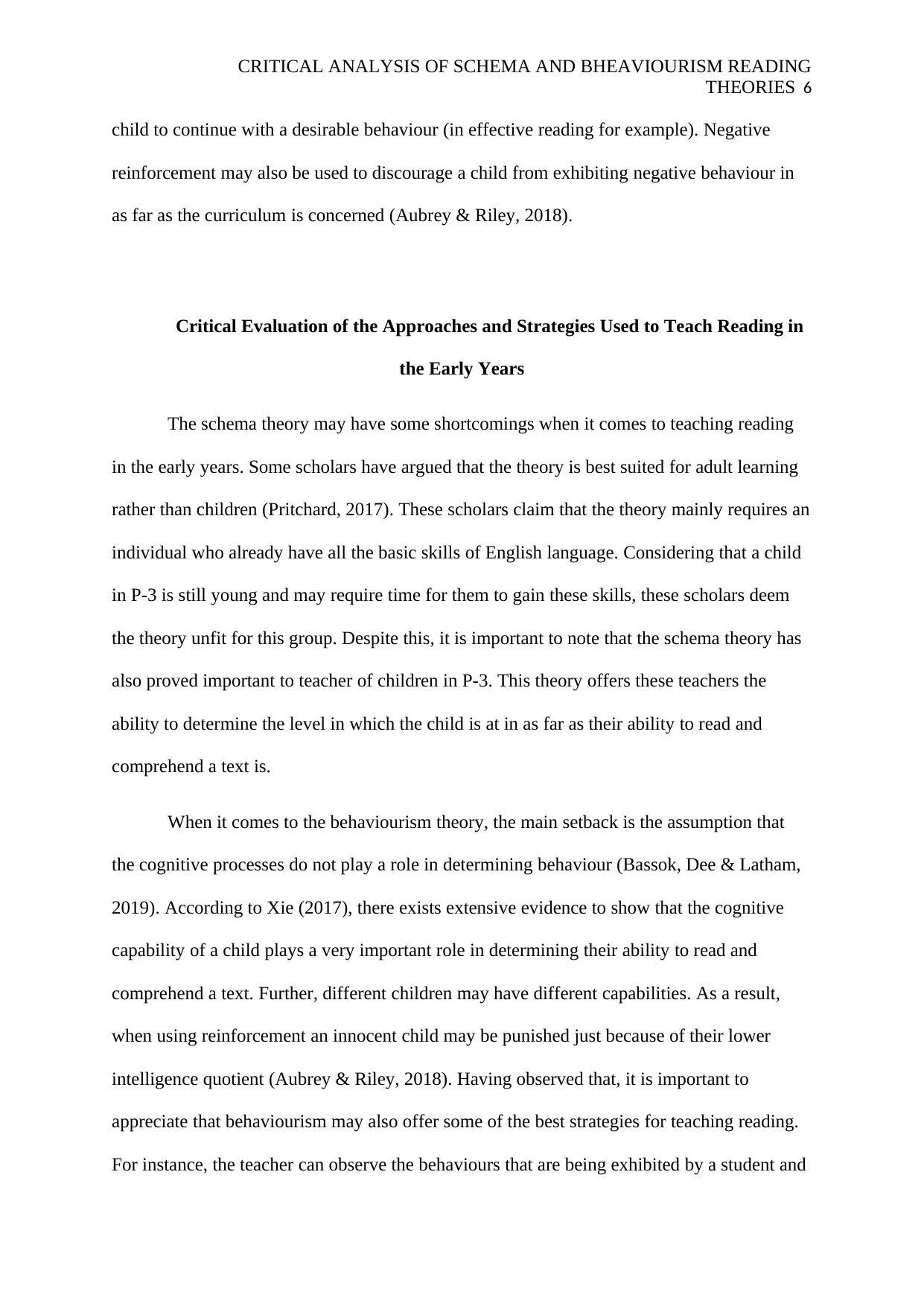
CRITICAL ANALYSIS OF SCHEMA AND BHEAVIOURISM READING
THEORIES 6
child to continue with a desirable behaviour (in effective reading for example). Negative
reinforcement may also be used to discourage a child from exhibiting negative behaviour in
as far as the curriculum is concerned (Aubrey & Riley, 2018).
Critical Evaluation of the Approaches and Strategies Used to Teach Reading in
the Early Years
The schema theory may have some shortcomings when it comes to teaching reading
in the early years. Some scholars have argued that the theory is best suited for adult learning
rather than children (Pritchard, 2017). These scholars claim that the theory mainly requires an
individual who already have all the basic skills of English language. Considering that a child
in P-3 is still young and may require time for them to gain these skills, these scholars deem
the theory unfit for this group. Despite this, it is important to note that the schema theory has
also proved important to teacher of children in P-3. This theory offers these teachers the
ability to determine the level in which the child is at in as far as their ability to read and
comprehend a text is.
When it comes to the behaviourism theory, the main setback is the assumption that
the cognitive processes do not play a role in determining behaviour (Bassok, Dee & Latham,
2019). According to Xie (2017), there exists extensive evidence to show that the cognitive
capability of a child plays a very important role in determining their ability to read and
comprehend a text. Further, different children may have different capabilities. As a result,
when using reinforcement an innocent child may be punished just because of their lower
intelligence quotient (Aubrey & Riley, 2018). Having observed that, it is important to
appreciate that behaviourism may also offer some of the best strategies for teaching reading.
For instance, the teacher can observe the behaviours that are being exhibited by a student and
THEORIES 6
child to continue with a desirable behaviour (in effective reading for example). Negative
reinforcement may also be used to discourage a child from exhibiting negative behaviour in
as far as the curriculum is concerned (Aubrey & Riley, 2018).
Critical Evaluation of the Approaches and Strategies Used to Teach Reading in
the Early Years
The schema theory may have some shortcomings when it comes to teaching reading
in the early years. Some scholars have argued that the theory is best suited for adult learning
rather than children (Pritchard, 2017). These scholars claim that the theory mainly requires an
individual who already have all the basic skills of English language. Considering that a child
in P-3 is still young and may require time for them to gain these skills, these scholars deem
the theory unfit for this group. Despite this, it is important to note that the schema theory has
also proved important to teacher of children in P-3. This theory offers these teachers the
ability to determine the level in which the child is at in as far as their ability to read and
comprehend a text is.
When it comes to the behaviourism theory, the main setback is the assumption that
the cognitive processes do not play a role in determining behaviour (Bassok, Dee & Latham,
2019). According to Xie (2017), there exists extensive evidence to show that the cognitive
capability of a child plays a very important role in determining their ability to read and
comprehend a text. Further, different children may have different capabilities. As a result,
when using reinforcement an innocent child may be punished just because of their lower
intelligence quotient (Aubrey & Riley, 2018). Having observed that, it is important to
appreciate that behaviourism may also offer some of the best strategies for teaching reading.
For instance, the teacher can observe the behaviours that are being exhibited by a student and
⊘ This is a preview!⊘
Do you want full access?
Subscribe today to unlock all pages.

Trusted by 1+ million students worldwide
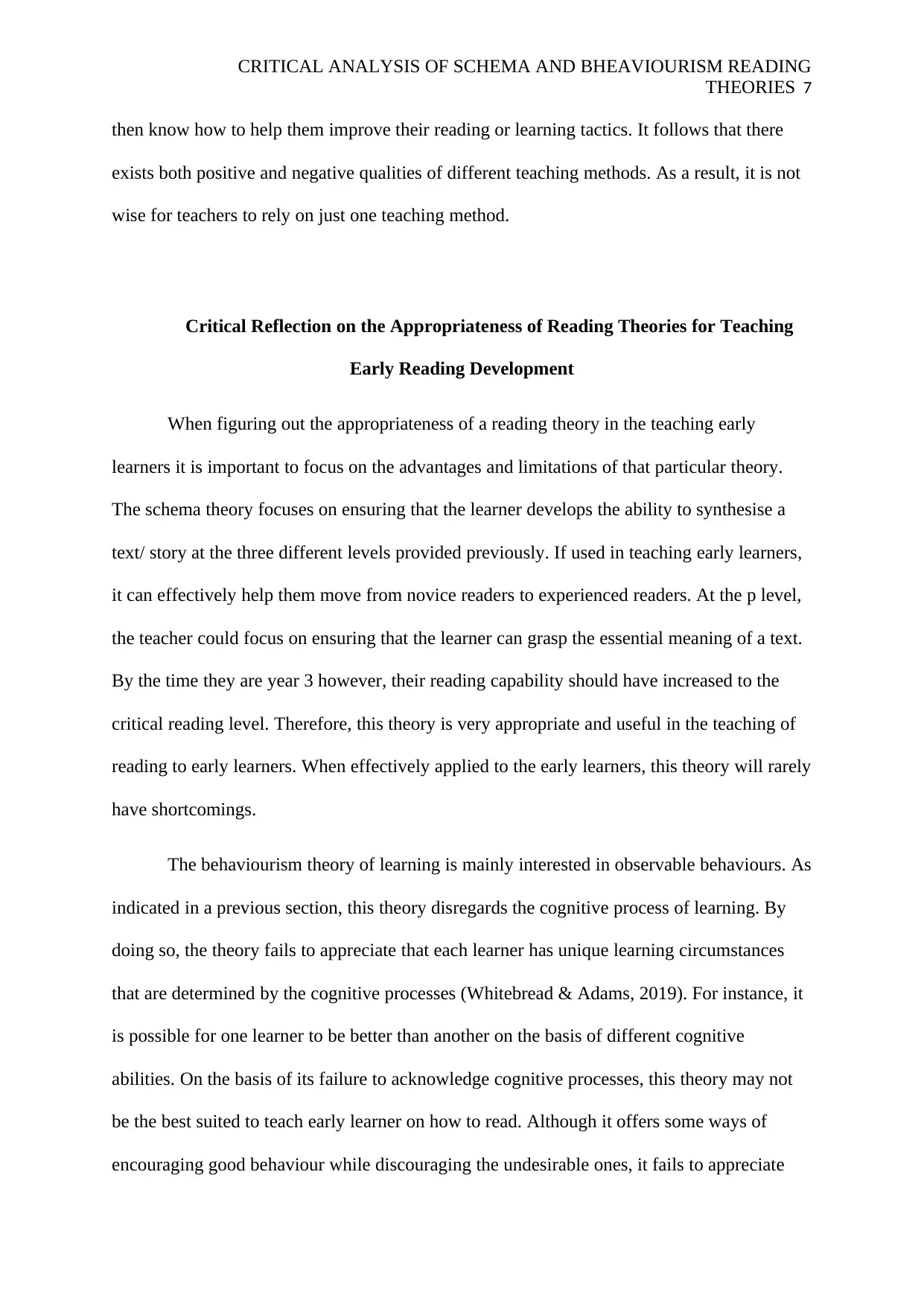
CRITICAL ANALYSIS OF SCHEMA AND BHEAVIOURISM READING
THEORIES 7
then know how to help them improve their reading or learning tactics. It follows that there
exists both positive and negative qualities of different teaching methods. As a result, it is not
wise for teachers to rely on just one teaching method.
Critical Reflection on the Appropriateness of Reading Theories for Teaching
Early Reading Development
When figuring out the appropriateness of a reading theory in the teaching early
learners it is important to focus on the advantages and limitations of that particular theory.
The schema theory focuses on ensuring that the learner develops the ability to synthesise a
text/ story at the three different levels provided previously. If used in teaching early learners,
it can effectively help them move from novice readers to experienced readers. At the p level,
the teacher could focus on ensuring that the learner can grasp the essential meaning of a text.
By the time they are year 3 however, their reading capability should have increased to the
critical reading level. Therefore, this theory is very appropriate and useful in the teaching of
reading to early learners. When effectively applied to the early learners, this theory will rarely
have shortcomings.
The behaviourism theory of learning is mainly interested in observable behaviours. As
indicated in a previous section, this theory disregards the cognitive process of learning. By
doing so, the theory fails to appreciate that each learner has unique learning circumstances
that are determined by the cognitive processes (Whitebread & Adams, 2019). For instance, it
is possible for one learner to be better than another on the basis of different cognitive
abilities. On the basis of its failure to acknowledge cognitive processes, this theory may not
be the best suited to teach early learner on how to read. Although it offers some ways of
encouraging good behaviour while discouraging the undesirable ones, it fails to appreciate
THEORIES 7
then know how to help them improve their reading or learning tactics. It follows that there
exists both positive and negative qualities of different teaching methods. As a result, it is not
wise for teachers to rely on just one teaching method.
Critical Reflection on the Appropriateness of Reading Theories for Teaching
Early Reading Development
When figuring out the appropriateness of a reading theory in the teaching early
learners it is important to focus on the advantages and limitations of that particular theory.
The schema theory focuses on ensuring that the learner develops the ability to synthesise a
text/ story at the three different levels provided previously. If used in teaching early learners,
it can effectively help them move from novice readers to experienced readers. At the p level,
the teacher could focus on ensuring that the learner can grasp the essential meaning of a text.
By the time they are year 3 however, their reading capability should have increased to the
critical reading level. Therefore, this theory is very appropriate and useful in the teaching of
reading to early learners. When effectively applied to the early learners, this theory will rarely
have shortcomings.
The behaviourism theory of learning is mainly interested in observable behaviours. As
indicated in a previous section, this theory disregards the cognitive process of learning. By
doing so, the theory fails to appreciate that each learner has unique learning circumstances
that are determined by the cognitive processes (Whitebread & Adams, 2019). For instance, it
is possible for one learner to be better than another on the basis of different cognitive
abilities. On the basis of its failure to acknowledge cognitive processes, this theory may not
be the best suited to teach early learner on how to read. Although it offers some ways of
encouraging good behaviour while discouraging the undesirable ones, it fails to appreciate
Paraphrase This Document
Need a fresh take? Get an instant paraphrase of this document with our AI Paraphraser
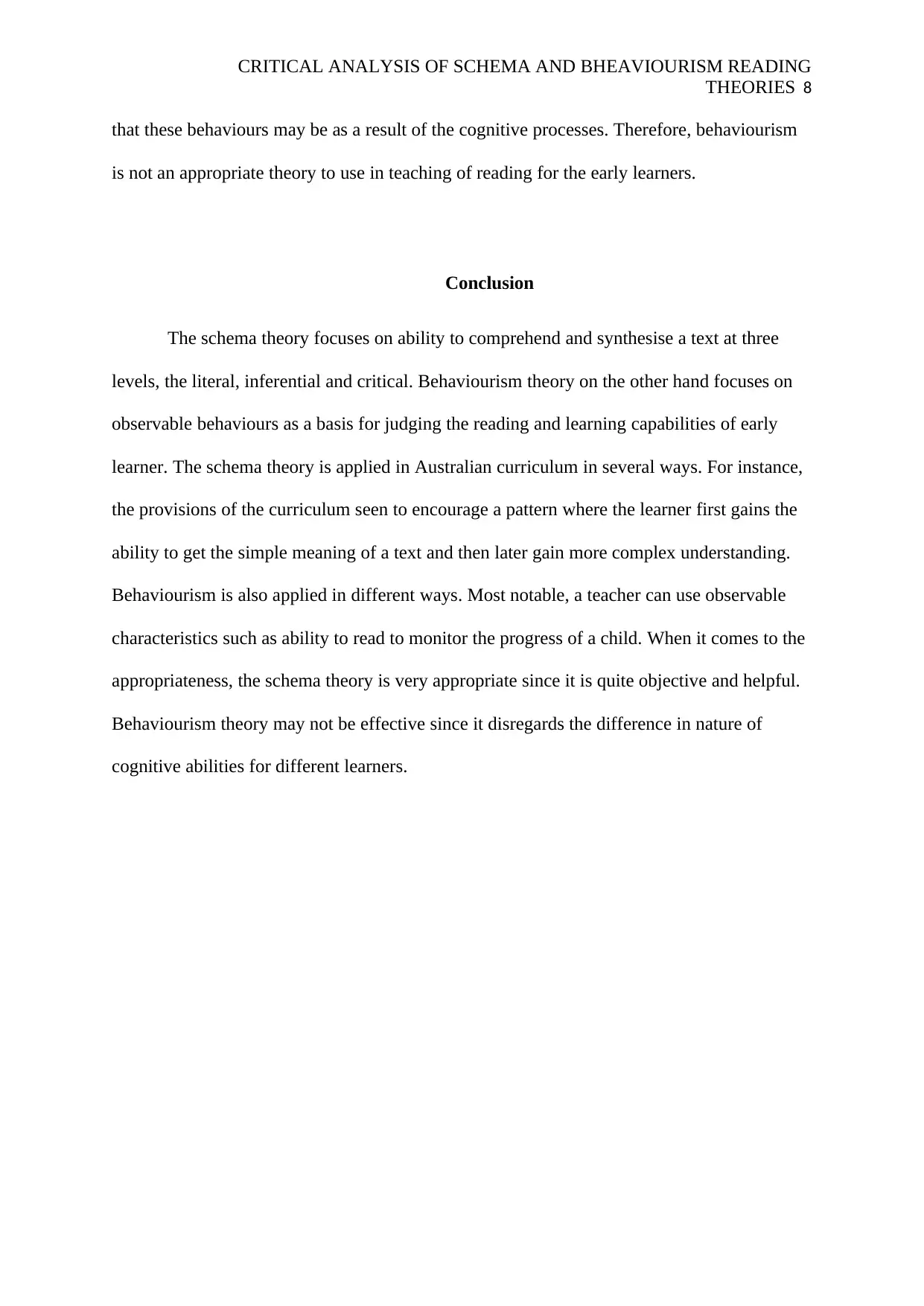
CRITICAL ANALYSIS OF SCHEMA AND BHEAVIOURISM READING
THEORIES 8
that these behaviours may be as a result of the cognitive processes. Therefore, behaviourism
is not an appropriate theory to use in teaching of reading for the early learners.
Conclusion
The schema theory focuses on ability to comprehend and synthesise a text at three
levels, the literal, inferential and critical. Behaviourism theory on the other hand focuses on
observable behaviours as a basis for judging the reading and learning capabilities of early
learner. The schema theory is applied in Australian curriculum in several ways. For instance,
the provisions of the curriculum seen to encourage a pattern where the learner first gains the
ability to get the simple meaning of a text and then later gain more complex understanding.
Behaviourism is also applied in different ways. Most notable, a teacher can use observable
characteristics such as ability to read to monitor the progress of a child. When it comes to the
appropriateness, the schema theory is very appropriate since it is quite objective and helpful.
Behaviourism theory may not be effective since it disregards the difference in nature of
cognitive abilities for different learners.
THEORIES 8
that these behaviours may be as a result of the cognitive processes. Therefore, behaviourism
is not an appropriate theory to use in teaching of reading for the early learners.
Conclusion
The schema theory focuses on ability to comprehend and synthesise a text at three
levels, the literal, inferential and critical. Behaviourism theory on the other hand focuses on
observable behaviours as a basis for judging the reading and learning capabilities of early
learner. The schema theory is applied in Australian curriculum in several ways. For instance,
the provisions of the curriculum seen to encourage a pattern where the learner first gains the
ability to get the simple meaning of a text and then later gain more complex understanding.
Behaviourism is also applied in different ways. Most notable, a teacher can use observable
characteristics such as ability to read to monitor the progress of a child. When it comes to the
appropriateness, the schema theory is very appropriate since it is quite objective and helpful.
Behaviourism theory may not be effective since it disregards the difference in nature of
cognitive abilities for different learners.
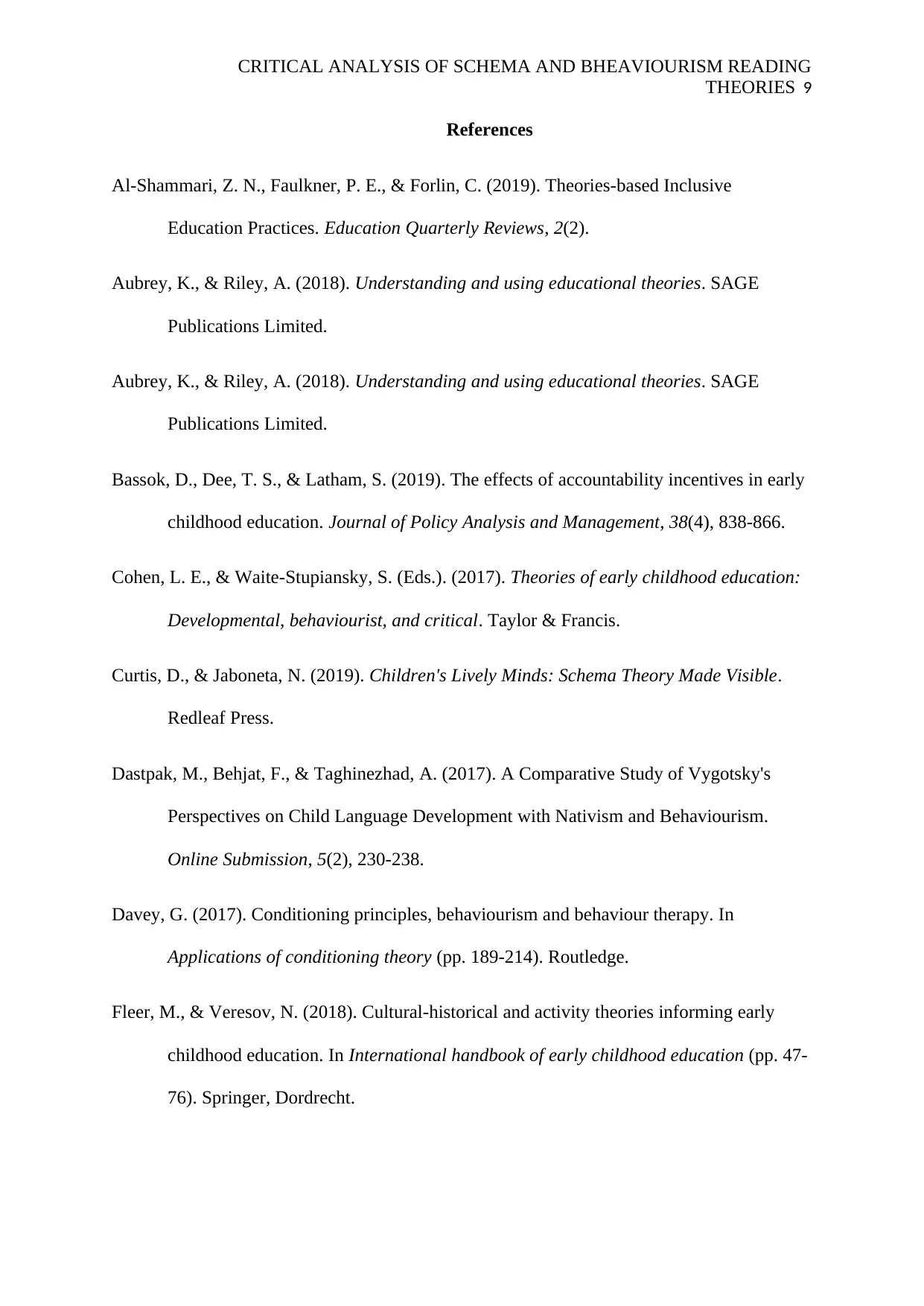
CRITICAL ANALYSIS OF SCHEMA AND BHEAVIOURISM READING
THEORIES 9
References
Al-Shammari, Z. N., Faulkner, P. E., & Forlin, C. (2019). Theories-based Inclusive
Education Practices. Education Quarterly Reviews, 2(2).
Aubrey, K., & Riley, A. (2018). Understanding and using educational theories. SAGE
Publications Limited.
Aubrey, K., & Riley, A. (2018). Understanding and using educational theories. SAGE
Publications Limited.
Bassok, D., Dee, T. S., & Latham, S. (2019). The effects of accountability incentives in early
childhood education. Journal of Policy Analysis and Management, 38(4), 838-866.
Cohen, L. E., & Waite-Stupiansky, S. (Eds.). (2017). Theories of early childhood education:
Developmental, behaviourist, and critical. Taylor & Francis.
Curtis, D., & Jaboneta, N. (2019). Children's Lively Minds: Schema Theory Made Visible.
Redleaf Press.
Dastpak, M., Behjat, F., & Taghinezhad, A. (2017). A Comparative Study of Vygotsky's
Perspectives on Child Language Development with Nativism and Behaviourism.
Online Submission, 5(2), 230-238.
Davey, G. (2017). Conditioning principles, behaviourism and behaviour therapy. In
Applications of conditioning theory (pp. 189-214). Routledge.
Fleer, M., & Veresov, N. (2018). Cultural-historical and activity theories informing early
childhood education. In International handbook of early childhood education (pp. 47-
76). Springer, Dordrecht.
THEORIES 9
References
Al-Shammari, Z. N., Faulkner, P. E., & Forlin, C. (2019). Theories-based Inclusive
Education Practices. Education Quarterly Reviews, 2(2).
Aubrey, K., & Riley, A. (2018). Understanding and using educational theories. SAGE
Publications Limited.
Aubrey, K., & Riley, A. (2018). Understanding and using educational theories. SAGE
Publications Limited.
Bassok, D., Dee, T. S., & Latham, S. (2019). The effects of accountability incentives in early
childhood education. Journal of Policy Analysis and Management, 38(4), 838-866.
Cohen, L. E., & Waite-Stupiansky, S. (Eds.). (2017). Theories of early childhood education:
Developmental, behaviourist, and critical. Taylor & Francis.
Curtis, D., & Jaboneta, N. (2019). Children's Lively Minds: Schema Theory Made Visible.
Redleaf Press.
Dastpak, M., Behjat, F., & Taghinezhad, A. (2017). A Comparative Study of Vygotsky's
Perspectives on Child Language Development with Nativism and Behaviourism.
Online Submission, 5(2), 230-238.
Davey, G. (2017). Conditioning principles, behaviourism and behaviour therapy. In
Applications of conditioning theory (pp. 189-214). Routledge.
Fleer, M., & Veresov, N. (2018). Cultural-historical and activity theories informing early
childhood education. In International handbook of early childhood education (pp. 47-
76). Springer, Dordrecht.
⊘ This is a preview!⊘
Do you want full access?
Subscribe today to unlock all pages.

Trusted by 1+ million students worldwide

CRITICAL ANALYSIS OF SCHEMA AND BHEAVIOURISM READING
THEORIES 10
Illeris, K. (2018). Learning, development and education: From learning theory to education
and practice. Routledge.
Neumann, K. L., & Kopcha, T. J. (2018). The use of schema theory in learning, design, and
technology. Tech Trends, 62(5), 429-431.
Odom, S. L. (2016). The role of theory in early childhood special education and early
intervention. In Handbook of early childhood special education (pp. 21-36). Springer,
Cham.
Pritchard, A. (2017). Ways of learning: Learning theories for the classroom. Routledge.
Schindler, H. S., McCoy, D. C., Fisher, P. A., & Shonkoff, J. P. (2019). A historical look at
theories of change in early childhood education research. Early Childhood Research
Quarterly, 48, 146-154.
Whitebread, D., & Adams, J. (2019). How Children Learn: Implications for Early Childhood
Education. The SAGE Handbook of Developmental Psychology and Early Childhood
Education, 309.
Xie, X. (2017). The influence of schema theory on foreign language reading comprehension.
The English Teacher, 9.
THEORIES 10
Illeris, K. (2018). Learning, development and education: From learning theory to education
and practice. Routledge.
Neumann, K. L., & Kopcha, T. J. (2018). The use of schema theory in learning, design, and
technology. Tech Trends, 62(5), 429-431.
Odom, S. L. (2016). The role of theory in early childhood special education and early
intervention. In Handbook of early childhood special education (pp. 21-36). Springer,
Cham.
Pritchard, A. (2017). Ways of learning: Learning theories for the classroom. Routledge.
Schindler, H. S., McCoy, D. C., Fisher, P. A., & Shonkoff, J. P. (2019). A historical look at
theories of change in early childhood education research. Early Childhood Research
Quarterly, 48, 146-154.
Whitebread, D., & Adams, J. (2019). How Children Learn: Implications for Early Childhood
Education. The SAGE Handbook of Developmental Psychology and Early Childhood
Education, 309.
Xie, X. (2017). The influence of schema theory on foreign language reading comprehension.
The English Teacher, 9.
1 out of 10
Related Documents
Your All-in-One AI-Powered Toolkit for Academic Success.
+13062052269
info@desklib.com
Available 24*7 on WhatsApp / Email
![[object Object]](/_next/static/media/star-bottom.7253800d.svg)
Unlock your academic potential
Copyright © 2020–2025 A2Z Services. All Rights Reserved. Developed and managed by ZUCOL.




